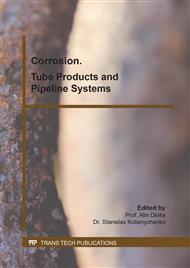p.1183
p.1190
p.1196
p.1203
p.1209
p.1218
p.1224
p.1230
p.1235
Test Analysis of Corrosion Perforation in a Crude Oil Gathering Pipeline
Abstract:
The reason for perforation leakage of gathering pipeline in an oilfield was investigated by size measurement, mechanical properties, metallographic structure, X-ray diffraction (XRD), scanning electron microscopy (SEM) and energy dispersive spectrum (EDS). The results showed that the failure form of the spirally submerged arc welded pipe (SAW) was the corrosion perforation caused by local corrosion. The main cause of corrosion perforation was due to the existence of chlorine ion, H2O and O2 in the pipeline transportation medium. A large cathode and small anode electrode corrosion formed in the pipe marking area and the base metal, which eventually led to the perforation of the steel pipe.
Info:
Periodical:
Pages:
1209-1217
Citation:
Online since:
May 2020
Authors:
Price:
Сopyright:
© 2020 Trans Tech Publications Ltd. All Rights Reserved
Share:
Citation:



